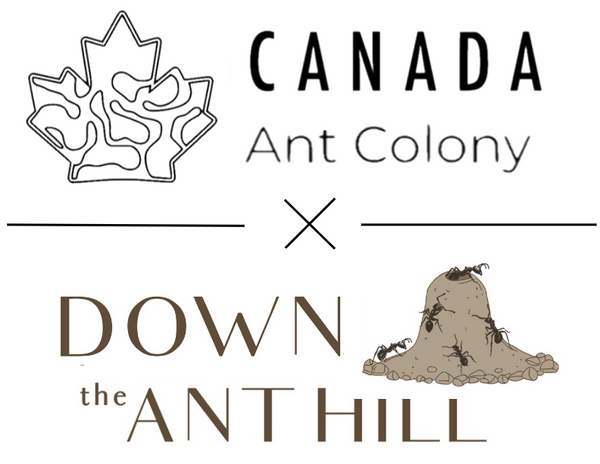Camponotus pennsylvanicus (also known black carpenter ants) are notorious house pests. People fear and hate them because of their reputation for nesting in walls. Although these ants are called carpenter ants, they much rather nest in soil and in trees than in your walls. These huge ants are quite active in the day and love their sugars!
If you're in Canada, you can purchase colonies of Eastern Black Carpenter Ants here. If you're in the US, you can purchase colonies of Eastern Black Carpenter Ants here.

Camponotus pennsylvanicus (Black Carpenter Ant) queen and worker sharing food
Taxonomy
Family: Formicidae
Subfamily: Formicinae
Tribus: Camponotini
Genus: Camponotus
Species: Camponotus pennsylvanicus
Basic info
Origin: Canada, United States.
Habitat: Enjoys warm temperatures but doesn’t necessarily need them, I have kept them in an air-conditioned room and they have done just fine. They enjoy a very moist nest with a good amount of darkness.
Colony form: monogynous
Colony size: 300-10.000 workers
Colony age: 15-18 years
Founding: fully claustral
Workers: polymorphic
Nesting: these ants dig nests into dirt and often burrow quite deep (at least a foot). They also love living in wood hence their name.
Hibernation: at least 4-5 months of hibernation at 4-6 degrees celsius.
Reproduction: nuptial flights in May and June.
Appearance
Workers (minors): Black head with black thorax. Gaster is black with a shiny tint. They also have black/brown legs. Small legs and are quite fast.
Workers (majors): Large black head with a black thorax. Their gasters are shiny and black. They have big legs and stand quite tall.
Queen: Black head with a light black thorax. Gaster is black and has a silver undertone. Also has a shiny tint on gaster. The queens have very large heads and huge gasters.
Drone: Dark brown head with black thorax. Gaster is black and the legs are semi-transparent.

Black Carpenter Ant (Credit: Katja Schulz)
Size
Workers: 4-14mm
Queens: 15-18mm long
Drones: around 5-7mm long
Development time at 75°F (24°C)
Egg to larvae: around 12 days
Larvae to pupa: around 15 days
Pupae to worker: Around 8 days
Egg to worker: 36 days
Ant keeping information
Recommendation: Great for beginners. Very big and easy to observe.
Temperature: 14-29° Celcius
Nesting types: Usually nests in dirt and wood. Can also be kept in cork and acrylic nests.
Formicarium size: Should fit the current colony size. Remember that colonies can become huge so the setup should be able to be expanded.
Formicarium accessories: heat source (optional).

Black Carpenter ants hibernating with mites
Substrate type: This species can walk well on most surfaces. Glass, vinyl tubing, acrylics, sand, clay and grout pose no issues. They can also climb vertical and upside down on glass but the larger workers may have problems with climbing steep vinyl tubing.
Behaviour
These ants are quite curious. They always investigate a sound or smell. I find they often leave the nest in packs.
They are slightly shy but if their nest is threatened they hold nothing back. Hhowever this changes with colony size - the larger the colony, the more aggressive.
Camponotus pennsylvanicus are very fun to watch hunt. They are constantly proactive and their majors help them a great deal.
They are most active during the day.
Additional information
Camponotus pennsylvanicus is very enjoyable to keep because they always give you something to watch. Not to mention their enormous brood that allows you to see every detail and every stage of development.
The workers love sugars and will create large-scale trails.
Workers stretch their prey out by the legs and dismember them while still alive.
Wild colonies can stretch over an enormous area with satellite nests up to 600 meters away from the main colonies. New studies indicate that larger colonies may have a tendency towards oligogyny.

Camponotus pennsylvanicus workers (Courtesy: Jeff Clark)
If you’re putting them into a natural set up, put your lighting outlet near the glass to produce heat and they will nest beside it.
Diet
Sugars
Camponotus pennsylvanicus love honey and sugar water. Other sugary liquids might work, too. From my experience, they LOVE fruits.
Protein
As for protein, they love nearly anything you give them. Fruit flies, flies, crickets, grashoppers and roaches are the most common foods given by antkeepers.
This guide was compiled and written by Daniel Cantin of the 'Ants and Antkeeping' discord server, which can be found here. https://discord.gg/YbZGvtR3
This guide has been posted with the permission of the authors. The original article may be found here. I have also made some edits based on my own observations
